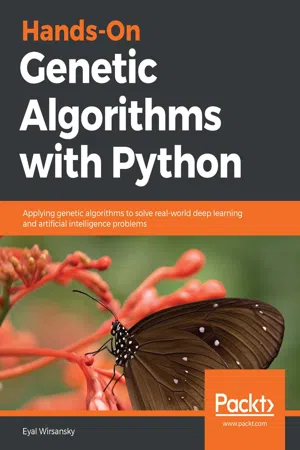
Hands-On Genetic Algorithms with Python
Applying genetic algorithms to solve real-world deep learning and artificial intelligence problems
- 346 pages
- English
- ePUB (mobile friendly)
- Available on iOS & Android
Hands-On Genetic Algorithms with Python
Applying genetic algorithms to solve real-world deep learning and artificial intelligence problems
About this book
Explore the ever-growing world of genetic algorithms to solve search, optimization, and AI-related tasks, and improve machine learning models using Python libraries such as DEAP, scikit-learn, and NumPy
Key Features
- Explore the ins and outs of genetic algorithms with this fast-paced guide
- Implement tasks such as feature selection, search optimization, and cluster analysis using Python
- Solve combinatorial problems, optimize functions, and enhance the performance of artificial intelligence applications
Book Description
Genetic algorithms are a family of search, optimization, and learning algorithms inspired by the principles of natural evolution. By imitating the evolutionary process, genetic algorithms can overcome hurdles encountered in traditional search algorithms and provide high-quality solutions for a variety of problems. This book will help you get to grips with a powerful yet simple approach to applying genetic algorithms to a wide range of tasks using Python, covering the latest developments in artificial intelligence.
After introducing you to genetic algorithms and their principles of operation, you'll understand how they differ from traditional algorithms and what types of problems they can solve. You'll then discover how they can be applied to search and optimization problems, such as planning, scheduling, gaming, and analytics. As you advance, you'll also learn how to use genetic algorithms to improve your machine learning and deep learning models, solve reinforcement learning tasks, and perform image reconstruction. Finally, you'll cover several related technologies that can open up new possibilities for future applications.
By the end of this book, you'll have hands-on experience of applying genetic algorithms in artificial intelligence as well as in numerous other domains.
What you will learn
- Understand how to use state-of-the-art Python tools to create genetic algorithm-based applications
- Use genetic algorithms to optimize functions and solve planning and scheduling problems
- Enhance the performance of machine learning models and optimize deep learning network architecture
- Apply genetic algorithms to reinforcement learning tasks using OpenAI Gym
- Explore how images can be reconstructed using a set of semi-transparent shapes
- Discover other bio-inspired techniques, such as genetic programming and particle swarm optimization
Who this book is for
This book is for software developers, data scientists, and AI enthusiasts who want to use genetic algorithms to carry out intelligent tasks in their applications. Working knowledge of Python and basic knowledge of mathematics and computer science will help you get the most out of this book.
Frequently asked questions
- Essential is ideal for learners and professionals who enjoy exploring a wide range of subjects. Access the Essential Library with 800,000+ trusted titles and best-sellers across business, personal growth, and the humanities. Includes unlimited reading time and Standard Read Aloud voice.
- Complete: Perfect for advanced learners and researchers needing full, unrestricted access. Unlock 1.4M+ books across hundreds of subjects, including academic and specialized titles. The Complete Plan also includes advanced features like Premium Read Aloud and Research Assistant.
Please note we cannot support devices running on iOS 13 and Android 7 or earlier. Learn more about using the app.
Information
Section 1: The Basics of Genetic Algorithms
- Chapter 1, An Introduction to Genetic Algorithms
- Chapter 2, Understanding the Key Components of Genetic Algorithms
An Introduction to Genetic Algorithms
- What are genetic algorithms?
- The theory behind genetic algorithms
- Differences between genetic algorithms and traditional algorithms
- Advantages and limitations of genetic algorithms
- When to use genetic algorithms
What are genetic algorithms?
Darwinian evolution
- The principle of variation: The traits (attributes) of individual specimens belonging to a population may vary. As a result, the specimens differ from each other to some degree; for example, in their behavior or appearance.
- The principle of inheritance: Some traits are consistently passed on from specimens to their offspring. As a result, offspring resemble their parents more than they resemble unrelated specimens.
- The principle of selection: Populations typically struggle for resources within their given environment. The specimens possessing traits that are better adapted to the environment will be more successful at surviving, and will also contribute more offspring to the next generation.
The genetic algorithms analogy
Genotype

Population

Fitness function
Selection
Table of contents
- Title Page
- Copyright and Credits
- Dedication
- About Packt
- Contributors
- Preface
- Section 1: The Basics of Genetic Algorithms
- An Introduction to Genetic Algorithms
- Understanding the Key Components of Genetic Algorithms
- Section 2: Solving Problems with Genetic Algorithms
- Using the DEAP Framework
- Combinatorial Optimization
- Constraint Satisfaction
- Optimizing Continuous Functions
- Section 3: Artificial Intelligence Applications of Genetic Algorithms
- Enhancing Machine Learning Models Using Feature Selection
- Hyperparameter Tuning of Machine Learning Models
- Architecture Optimization of Deep Learning Networks
- Reinforcement Learning with Genetic Algorithms
- Section 4: Related Technologies
- Genetic Image Reconstruction
- Other Evolutionary and Bio-Inspired Computation Techniques
- Other Books You May Enjoy